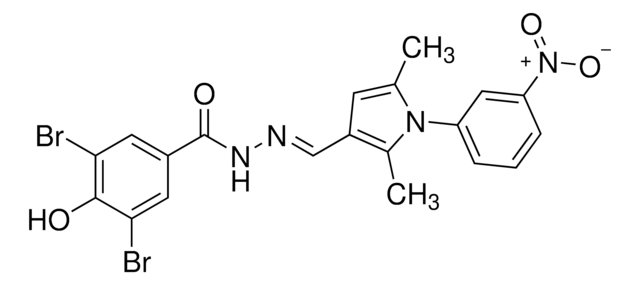M8515
Monastrol
≥98% (HPLC), solid
Synonyme(s) :
4-(3-Hydroxyphenyl)-6-methyl-2-thioxo-1,2,3,4-tetrahydro-4H-pyrimidin-5-carboxylic Acid Ethyl Ester
About This Item
Produits recommandés
Niveau de qualité
Pureté
≥98% (HPLC)
Forme
solid
Conditions de stockage
protect from light
Couleur
white to off-white
Pf
185-185.9 °C (lit.)
Solubilité
DMSO: >5 mg/mL
Température de stockage
2-8°C
Chaîne SMILES
CCOC(=O)C1=C(C)NC(=S)NC1c2cccc(O)c2
InChI
1S/C14H16N2O3S/c1-3-19-13(18)11-8(2)15-14(20)16-12(11)9-5-4-6-10(17)7-9/h4-7,12,17H,3H2,1-2H3,(H2,15,16,20)
Clé InChI
LOBCDGHHHHGHFA-UHFFFAOYSA-N
Application
- to treat MDA-MB-231 cells as a non-microtubule-targeting agent
- as a antineoplastic agent, to treat mouse myeloma cell line SP 2/0, to induce apoptosis and to elucidate the role of metabotropic glutamate receptor 3 (Grm3) in apoptosis
- as an inhibitor of pteridine reductase in GFP-transfected promastigotes infected macrophages for flow cytometer-based growth inhibition assay and to evaluate anti-leishmanial activity of Leishmania donovani hamster model in vivo
Actions biochimiques/physiologiques
Caractéristiques et avantages
Conditionnement
Code de la classe de stockage
11 - Combustible Solids
Classe de danger pour l'eau (WGK)
WGK 3
Point d'éclair (°F)
Not applicable
Point d'éclair (°C)
Not applicable
Équipement de protection individuelle
Eyeshields, Gloves, type N95 (US)
Certificats d'analyse (COA)
Recherchez un Certificats d'analyse (COA) en saisissant le numéro de lot du produit. Les numéros de lot figurent sur l'étiquette du produit après les mots "Lot" ou "Batch".
Déjà en possession de ce produit ?
Retrouvez la documentation relative aux produits que vous avez récemment achetés dans la Bibliothèque de documents.
Articles
Apoptosis regulation involves multiple pathways and molecules for cellular homeostasis.
Cell cycle phases (G1, S, G2, M) regulate cell growth, DNA replication, and division in proliferating cells.
Notre équipe de scientifiques dispose d'une expérience dans tous les secteurs de la recherche, notamment en sciences de la vie, science des matériaux, synthèse chimique, chromatographie, analyse et dans de nombreux autres domaines..
Contacter notre Service technique








